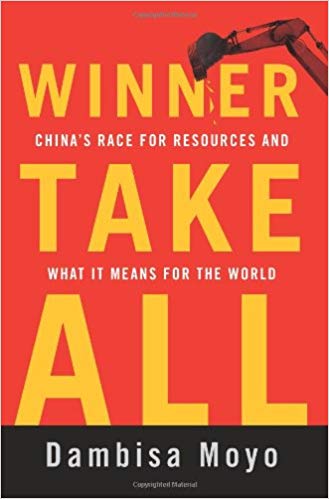By Doreen Muyonga
Author : Dambisa Felicia Moyo
Publisher : Penguin Press (2012)
Introduction
The author of this book Dambisa Felicia Moyo is a Zambian by birth. Moyo is a renowned International Economist and award winning author. Three themes are exhaustively discussed in the ten chapters provided in this book. This book advances the economic aftermaths of China becoming the lead buyer of world resources.
What these really means is that China has ascended to become the biggest source of capital infusions with rich and poor countries trying everything they can to be in the right books of the Chinese. The author submits that China’s growing might is being felt by America, South America, Europe, Australia and Africa. Again, China’s ballooning financial capabilities have trickled down to global commodity markets. It is no wonder that China has risen to be the giant buyer and a price determining power.
More importantly, the author showcases China’s global commodity campaign. Moyo (2012:9) concedes that in a short period of time, China has climbed the ladder to become a force to reckon with in the global market. Moyo (2012:10) forecasts that commodity dynamics could fuel conflicts and wars in the future and so she encourages the rest of the world to focus their attention on availability of resources since majority of governments are poorly prepared for such scenarios.

Moyo (2012:10) warns that shortage of resources like oil, minerals, water and land could escalate prices to imaginable levels. Further, the scholar cautions that the issue of limited resources could plunge the international system in a crisis. Moyo (2012:11) posits that China is not leaving anything to chance, it has gone omnipresent and omnipotent and so the costs of its activities will be felt by the entire world.
In addition, Moyo (2012:12) showcases the social and political effects of China’s pursuit for resources. Simply put, China’s role is likely to influence geopolitics as well as determining how people live and relate with their governments. The author argues that China has gigantic wealth, enormous economic and political discipline which gives it the ability to do what others are not able of performing. For instance, China’s political infrastructure executes the governments agenda with individuals, corporations and the communist party pulling in the same direction. In addition, the state holds majority of the shares in most of the public companies.
Again, China thrives in tactical sectors such as oil, minerals and infrastructure. Moyo (2012:15) reveals that China’s approach of enabling its companies to access low cost money, Chinese state commendation and special access to foreign government contacts is an added advantage. Further, Moyo (2012:68) advances the argument that China’s financial might enables it to obtain commodities that other states cannot. These has translated to a remarkable economic record for China, with trade being its going out strategy.
More importantly, Moyo (2012:104) argues that China has forged close relationships with host states almost to the point of existence. Consequently, China’s success has been marred by controversies with allegations of advancing neo colonialism staring at them. Moyo (2012:132) points out that China’s aggressiveness has raised disquiets with regards to geopolitics and sovereignty. The author also points to the scenario where China could totally take over the global commodity if it so wishes. Finally, Moyo (2012:166) concludes that there is a global resource curse and that the contest for survival on earth is a matter of life and death.
Central thesis
The central thesis of this book, Moyo (2012:10) is that supply and demand for commodities is going to affect the future a great deal and China seems to be on top of these situation. The author argues that with the speedy increase in population from the current seven billion to ten billion by the year 2100, the rate of economic development and global wealth will be unmatched causing the evolving markets to deliver three billion new humans beings into the global middle class.
The author maintains that this trend will lead to a mammoth rate of urbanization and straining of commodity resources. The author adds that there is no adequate land, water, energy and minerals to sustain the ballooning population. In addition, the author maintains that China is definitely the only country in the world with a clear cut out plan for securing resources.
For instance, China has put a “welcome mat” for all at its door causing it to seal deals with undeveloped countries that are thirsty for economic development. Further, the author reveals that competition for these threatened resources will lead to prices of commodities shooting as well as numerous wars.
Critical evaluation
The title of the book Winner Take All is attention gripping and quite alarming yet the author paints rather a familiar script in her discussion, that of human beings depleting key commodities they rely on for existence. Simply put, the author has little to add to existing knowledge. It therefore goes without saying that this book does not hold the ultimate word on resource depletion.
Though the author provides a wide-ranging analysis of themes, that is economic, political and social implications of Chinese quest for resources, I find the book deceptive and inconsistent in presentation of arguments. For instance, it is not strange that China being the third largest state accounting for one sixth of the world population would be the at the peak in consumption of resources.
The book lacks originality and provides very naive facts. The author has mostly relied on works of other scholars to advance her arguments which are still too limited. The author finds herself at pains to justify her very own arguments. For instance, Moyo (2012:19) begins chapter one discussion by relying on information from Kaplan (1994). Again, while beginning discussion on chapter two, Moyo (2012:27) uses China’s Zhou Shengxian speech to build her discussion. In addition, the most worrying trend in this book is the authors overreliance on UN reports.
More importantly, Moyo (2012:136) reveals that Chinese have been accused of poor working conditions and that these claims are worth investigating. One wonders really if the author subjected this work to vigorous research. What comes out clear is that the author relied mostly on desktop research.
The author provides a rather biased argument throughout her discussion. It goes without saying that Moyo (2012:140) is on a worldwide mission to assemble encouraging views for China. On the other side, Moyo (2012:180) mounts attacks at the US by lecturing them on how to make friends the way China does. Again, Moyo (2012:185) goes on with her attacks at America, she prescribes that America should channel its energy and resources from military to investment in basic commodities like food, water and minerals just like China. Additionally, Moyo (2012:132) insinuates that the claims of China advancing neo-colonialism are baseless.
Moyo (2012:138) also dismisses claims that Chinese create faulty constructions using low quality materials. Further, Moyo (2012:164) argues that for people to understand supply and demand then they have to begin by understanding the Chinese agenda. Moyo (2012:175) emphasizes that China seems to the only state preparing for commodity shortage. These points towards the authors subjective views and preference of China to America.
The book is full of speculations. The authors tendency to offer predictions without providing a premise for them is quite disturbing. For instance, Moyo (2012:22) predicts that two billion people will cross over to the global middle class by 2030. Also, Moyo (2012:37) forecasts that global water demand will drain the available supply by forty years. The author finds difficulty in revealing the premise of these predictions which makes one to wonder why and how the author arrived at them.
In an attempt to redeem herself, Moyo (2012:149) nails it when she exposes that close to one million people sleep hungry and the situation is deteriorating as days go by. The author rightfully blames it on the issue of food wastage, allocations of food and lack of well thought out policies on food production.
Moreover, Moyo (2012:51) accurately observes that powerful states go to the extent of transacting with undemocratic regimes as long as they obtain oil. The author adds that governments do not care about its people, they have developed a great appetite for personal gains from foreign money. The book also reveals damning revelations about OPEC. Moyo (2012:115) discloses instances of collusion in oil production and pricing. More importantly, Moyo (2012:113) exposes a vacuum which aids the Chinese increasing their market share and control worldwide.
The author embraces the use of figures to illustrate her arguments further, this can be seen in all the book chapters. This technique is useful since it makes it easier for the reader to understand her argument and builds a strong base for her arguments as well. For instance, Moyo (2012: 20) uses figures 1.1 to showcase the skyrocketing world population. In addition, Moyo (2012:46) adopts figure 3.1 to demonstrate the yearly prices of crude oil. Further, the author cites relevant examples which readers can easily relate with. Moyo (2012:107) while explaining monopsony, gives an example of a relationship between a big supermarket and a farmer whereby the supermarket has the luxury of sourcing a commodity from different sellers.
The book is rich in satire. Moyo (2012:73) satirizes that during the Sino-African summit, the streets of Beijing were colored with flags of African states so as to please the African delegation and make them feel at home.
Last but not least, though the authors focus on China makes the book compelling to read, the reader loses the patience to continue reading the book to the end because of hollow and unconvincing arguments to say the least. The fact that the author escapes to discuss Road and Belt initiative as China’s Soft power strategy is inexcusable. Overall, the arguments advanced in this book are exaggerated therefore the book cannot inspire any action whatsoever.













